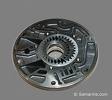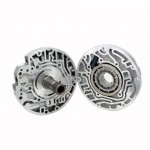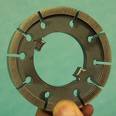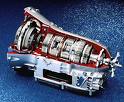The story I am going to tell you is a really common story heard by every competent tranmsission shop. This story is about a customer with a Ford F-350 Super Duty dual rear wheel pickup. It applies to all Ford trucks: F-150, F-250, F450 and any truck with an EDOD series transmission or AODE/4R70w transmission.
Here we go: The man is going up Route 95 pulling a load, not an overload, at 70 mph ish. It is a hot day since I/we live in Florida. All of a sudden the truck starts to slow down and stops moving as you get to the side of the road. Looking under the truck he sees ATF (automatic transmission fluid)Â pouring out between the engine and transmission. This a front pump leak. Angrily he calls a tow truck or calls our shop and we send a tow truck.
Once the truck gets to our shop we go through our usual diagnostic procedure. The first thing we do in this case is to check the fluid amount and quality. Most of the time the fluid stinks, the tranmsission may be damaged from the slippage due to the fluid loss. So we go ahead and start the truck and fill it up with the proper transmission fluid so we can locate the leak. Well low and behold it is not leaking now. What the heck is going on here?
Here is what happened. The transmission got so hot that it softened the front pump seal and caused it to literally purge the transmission of fluid. Sort of like a syphon effect, once it starts it won’t stop until it is out of fluid or you turn the engine off. By the time we get the vehicle towed in and looked at, it has cooled off. If the seal is not ruined entirely than it may return to it’s basic original condition and not leak. So, should we just change the bad fluid and let the customer go?
Realistcally speaking, no. We should discuss with our consumer and advise them that the seal may not be leaking at this moment, but you can guarantee it will leak again. When: we don’t know, but most likely it will leak soon after it gets good and hot again. Simply put, it will leak again. The recommended procedure for this would be to remove the transmission.
After removal we suggest an entire transmission inspection to make sure no internal damage is found. If no other problems are obvious than a good old fashioned reseal is in order. This procedure is basically a rebuild of the front pump. The front pump bushing, gasket and o-ring seal should be replaced along with a genuine Ford front pump seal. An excellent modification that can be done with the transmission out is to enlarge the drainback hole in the front section of the pump.
Once the cooling system is flushed out and the transmission is reinstalled and filled with Ford blended synthetic transmission fluid it is time to hook up the scanner tool and go for a ride. We hope to see no codes, but in most case you may find a ‘ficticious’ code since the trans was slipping at one point. We clear the codes and go on a test drive. When we return, we should have no codes. If that is the case we have been successful. The last thing is to give it a good leak check and clean of any finger prints.
GotTransmissions.com Blog is a wealth of helpful consumer information. GotTranmsissions.com is the most qualified transmission supplier in the country. If the transmission is damaged to a point of replacement you may want to try a good used transmission. If so call GotTransmsions.com at 866-320-1182.








